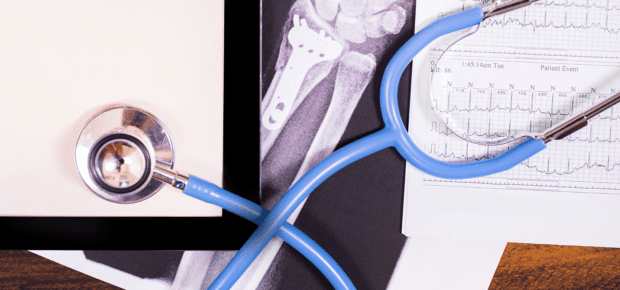July 27, 2017
When something is wrong we go to the doctor and we begin what is ideally a two-step process: diagnosis and therapy. Artificial intelligence (AI) will transform both aspects of health care by adding powerful new tools to the doctor’s bag.
A range of diverse, compelling research projects around AI-driven diagnoses are underway. For example, an international community (including Google’s Brain project) competes in an annual challenge to correctly diagnose breast cancer in 400 expert-labeled microscopic images of biopsy samples. The best results so far? About 99 percent of the slides were identified correctly by a project from Harvard and Massachusetts Institute of Technology.
Another example is Google’s Deep Mind project, which has achieved 90 to 97 percent accuracy in diagnosing diabetic retinopathy. Importantly, the algorithm’s training required a huge medical effort to label the correct diagnosis for 128,000 retinal images.
Asking the right questions
In 2017, with today’s huge computational resources, and the growing availability of significant training sets, such algorithms perform within the variability of human medical experts. Before this capability has broad impacts however, more questions remain. Can such automated tools be deployed in a way that truly increases access to medical care for patients? Can it be demonstrated that better outcomes occur? Can it improve our knowledge of which procedures work? These are hurdles that any new medical innovation must eventually jump.
Experts’ time is expensive and when they are labeling training data for computers, they are not using their skills on real patients. A Seattle startup called C-SATS is using crowd workers to evaluate surgical skill in videos of student operations — a method they validated as equivalent to expert surgeon raters. This could be a scalable way to generate the huge training data sets required for machine learning to subsequently automate the evaluation.
Integrating algorithms
Once you are diagnosed, your treatment will also be augmented with AI. Recent National Institutes of Health-sponsored work in our laboratory at the University of Washington, using the Raven-II research system from Applied Dexterity, is showing how surgeons’ finely honed human skills will be augmented by AI while preserving their ability to exercise experience and judgement. AI algorithms such as behavior trees from video games are being adapted to medicine and extended to allow the surgeon to grant a degree of trust to the robot. As a result, faint fluorescent labels on tumor margin cells, invisible to the surgeon, are treated to prevent recurrence. Other groups such as University of California, Berkeley, and University of California, Los Angeles, and Sheikh Zayed Institute for Pediatric Surgical Innovation have similar projects in the works. All face rigorous regulatory processes before treating patients.
AI can help plan difficult surgery such as in the pituitary gland, roughly in the center of the skull. Using multi-factorial optimization, an algorithm also developed at the University of Washington searches the patient’s 3-D scan for a pathway to the tumor through the face, eyes, nose or skull, which is the safest and least disruptive.
Before you are sick and after you are discharged from the hospital, AI will deeply analyze big data to monitor your recovery and overall well-being. Data collected with permission of individual patients, such as the 10,000-subject Baseline study conducted by Google’s Verily organization, will help to validate effectiveness of therapies and to find statistically valid predictors based on everything from your DNA to your walking and sleep patterns, to catch cancer before it is causing noticeable symptoms, when it can be more easily cured.
There is little doubt that AI’s current rapid pace will revolutionize health care, even if only a fraction of today’s promising results bear fruit.
Blake Hannaford , IEEE Fellow and Professor of Electrical Engineering and Biorobotics Laboratory Director, University of Washington





 Meaningful Momentum or Running in Place?
Meaningful Momentum or Running in Place? AI Through Our Ages
AI Through Our Ages Liquid Infrastructure: Our Planet's Most Precious Resource
Liquid Infrastructure: Our Planet's Most Precious Resource The Impact of Technology in 2025
The Impact of Technology in 2025 Quantum and AI: Safeguards or Threats to Cybersecurity?
Quantum and AI: Safeguards or Threats to Cybersecurity? Why AI Can't Live Without Us
Why AI Can't Live Without Us Bits, Bytes, Buildings and Bridges: Digital-Driven Infrastructure
Bits, Bytes, Buildings and Bridges: Digital-Driven Infrastructure Impact of Technology in 2024
Impact of Technology in 2024 Emerging AI Cybersecurity Challenges and Solutions
Emerging AI Cybersecurity Challenges and Solutions The Skies are Unlimited
The Skies are Unlimited Smart Cities 2030: How Tech is Reshaping Urbanscapes
Smart Cities 2030: How Tech is Reshaping Urbanscapes Impact of Technology 2023
Impact of Technology 2023 Cybersecurity for Life-Changing Innovations
Cybersecurity for Life-Changing Innovations Smarter Wearables Healthier Life
Smarter Wearables Healthier Life Infrastructure In Motion
Infrastructure In Motion The Impact of Tech in 2022 and Beyond
The Impact of Tech in 2022 and Beyond Cybersecurity, Technology and Protecting Our World
Cybersecurity, Technology and Protecting Our World How Technology Helps us Understand Our Health and Wellness
How Technology Helps us Understand Our Health and Wellness The Resilience of Humanity
The Resilience of Humanity Harnessing and Sustaining our Natural Resources
Harnessing and Sustaining our Natural Resources Creating Healthy Spaces Through Technology
Creating Healthy Spaces Through Technology Exceptional Infrastructure Challenges, Technology and Humanity
Exceptional Infrastructure Challenges, Technology and Humanity The Global Impact of IEEE's 802 Standards
The Global Impact of IEEE's 802 Standards Scenes of our Cyber Lives: The Security Threats and Technology Solutions Protecting Us
Scenes of our Cyber Lives: The Security Threats and Technology Solutions Protecting Us How Millennial Parents are Embracing Health and Wellness Technologies for Their Generation Alpha Kids
How Millennial Parents are Embracing Health and Wellness Technologies for Their Generation Alpha Kids Space Exploration, Technology and Our Lives
Space Exploration, Technology and Our Lives Global Innovation and the Environment
Global Innovation and the Environment How Technology, Privacy and Security are Changing Each Other (And Us)
How Technology, Privacy and Security are Changing Each Other (And Us) Find us in booth 31506, LVCC South Hall 3 and experience the Technology Moon Walk
Find us in booth 31506, LVCC South Hall 3 and experience the Technology Moon Walk Virtual and Mixed Reality
Virtual and Mixed Reality How Robots are Improving our Health
How Robots are Improving our Health IEEE Experts and the Robots They are Teaching
IEEE Experts and the Robots They are Teaching See how millennial parents around the world see AI impacting the lives of their tech-infused offspring
See how millennial parents around the world see AI impacting the lives of their tech-infused offspring Take the journey from farm to table and learn how IoT will help us reach the rising demand for food production
Take the journey from farm to table and learn how IoT will help us reach the rising demand for food production Watch technical experts discuss the latest cyber threats
Watch technical experts discuss the latest cyber threats Explore how researchers, teachers, explorers, healthcare and medical professionals use immersive technologies
Explore how researchers, teachers, explorers, healthcare and medical professionals use immersive technologies Follow the timeline to see how Generation AI will be impacted by technology
Follow the timeline to see how Generation AI will be impacted by technology Learn how your IoT data can be used by experiencing a day in a connected life
Learn how your IoT data can be used by experiencing a day in a connected life Listen to technical experts discuss the biggest security threats today
Listen to technical experts discuss the biggest security threats today See how tech has influenced and evolved with the Games
See how tech has influenced and evolved with the Games Enter our virtual home to explore the IoT (Internet of Things) technologies
Enter our virtual home to explore the IoT (Internet of Things) technologies Explore an interactive map showcasing exciting innovations in robotics
Explore an interactive map showcasing exciting innovations in robotics Interactively explore A.I. in recent Hollywood movies
Interactively explore A.I. in recent Hollywood movies Get immersed in technologies that will improve patients' lives
Get immersed in technologies that will improve patients' lives